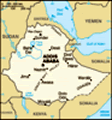Advertisement
Published: January 12th 2011
I. Obelisks and Churches
As a history teacher/buff (buff teacher?), I figured I might as well start at the beginning, if I were going to tackle Ethiopia’s “historical circuit”. But this meant that I would actually have to start almost midway in the geographic arch of that circuit, at least as it is usually followed by tourists setting forth from Addis Ababa. So, after a day in Addis to decompress from Djibouti and to acclimate to a new language and culture, I hopped on a flight that might as well have been an aerial bus service – its stops included Bahir Dar, Gonder, Lalibela, and, finally, my destination: Aksum (Axum).
Obviously, I have known of Ethiopia for a long time (alas, those 1980s images of starving
children are still what many Americans associate with the country); however, as I started teaching world history, I came to find out that Ethiopia had one of the richest and most mysterious histories in Africa. I learned, along with my students, a bit about the ancient empire of Aksum, which was linked through an extensive trade network northward to the Mediterranean, westward and southward into sub-Saharan African, and eastward to Arabia and the Indian Ocean world. Indeed, at one point, Aksum was one of the most powerful empires in the world. I also learned that its rulers erected enigmatic stelae, including some that are among the largest monuments carved out of a single stone. So, of course, I had to go see Aksum and its famous stelae firsthand. Stop #1 on my Ethiopia tour!
***
Present-day Aksum is not much more than a small town – a sort of long, strangly town – but it remains significant not only for its history as the center of the first major “Ethiopian” state but also as the most important center of Ethiopian Christianity (which arrived near the end of the Aksumite Empire). These two parts of the city’s identity appropriately face
off at the northern edge of Aksum: the main stelae field and the St. Mary of Zion Complex being on opposite sides of an ill-defined “square”.
I started with the stelae, as these were (mostly) pre-Christian. Didn’t want to mess up the chronology! Despite this being one of the most important archaeological sites in sub-Saharan Africa, and a place proudly promoted by Ethiopia’s tourism board, I was quite surprised to find that I had the place almost entirely to myself. I saw only one “faranji” (the Ethiopian term for foreigner, not a star trek figure – it’s sort of their equivalent of “khawaja”*) the entire time I was poking around.
Though the area is peppered with the stone pillars/obelisks, there’s a cluster of three that steal the show – two of which are standing, one that lies where it collapsed (probably haven fallen as it was being erected). There is King Ezana’s Stele, slightly off kilter, like an Aksumite Tower of Pisa, and the Rome Stele, the second largest stele to be carved and the largest to stay standing (though it is called the Rome Stele since it was carted off to Italy on Mussonlini’s orders after the
Italians forcefully colonized Ethiopia in the 1930s – it wasn’t returned to Aksum until 2005!). Both of these stelae are impressive in size and beautiful in form. Lying next to them, however, is the stele that would have outshined all the others – had it not toppled almost immediately. The Great Stele would have stood 33 meters tall, nearly 10 meters higher than the Rome Stele. Like the Tower of Babel, its fall is popularly viewed as the sign of pagan Aksum’s collapse and the emergence of Christianity as a force in Ethiopia.
But there is more than meets the eye at the stelae field. Beneath the stone monuments there is a warren of tombs and tunnels, only a fraction of which have been excavated. There are a couple tombs that you can duck into now, but you sort of have to wonder what else lays below the surface of Aksum….
***
When I first wandered into the St. Mary of Zion church complex in the mid afternoon, I was a little baffled to find that there was no ticket agent around. And even more baffled that no one seemed to care that a faranji was wandering the
grounds without a ticket (this is always a concern here). I soon realized everyone was off to afternoon prayers. This meant, on one hand, that I couldn’t actually enter the churches; on the other, however, I could enjoy the compound relatively undisturbed. The only time I caused any concern was when I advertently got too close to the Chapel of the Tabot – or the Ark of the Covenant.
Yes, that Ark of the Covenant.
Ethiopians believe that they possess the original Ark, guarded by a special priest in a vault below an innocuous little chapel. Of course, no one is allowed to see it (sort of in the Indiana Jones vein people believe it would kill you to lay eyes on the Ark). So, you just have to take the priests’ word that it is in there, somewhere.
Since I did want to see the interior of the churches – especially the oldest, built during the time of King Fasilada, and which looks more like a castle than a church – I went back after prayers had finished. Now there was a ticket agent, selling tickets at what seemed a shockingly high price for Ethiopia –
150 birr (about $9). Considering that the ticket for the stelae field (which also included all the other secular historical sites around town) costs only 50 birr ($3), and lasts for 3-4 days, the entrance fee to the church complex seemed a gouge. But I really wanted to see the paintings in the church. (And I was not going to put up a fuss like the German guy in front of me, who got upset to find that women were not allowed inside the church – his feminist indignation seemed a little out of place in this most patriarchal of societies!)
Inside the old church, the stone walls were unadorned. Large curtains hung over the front wall and altar. I began to wonder if it had been worth forking out the birr just to enter. But then a priest appeared out of nowhere and lifted the curtains, one by one, to reveal the brightly colored icons for which Ethiopian Christianity is so well known. I thought: ok, it was worth it.
II. On Top of the World
About halfway up, dangling off the face of the cliff, I came to the conclusion that I wasn’t going
to make it. Both in the sense of not actually getting to the monastery and in the bigger sense of staying alive.
I was being hauled up to an ancient monastery by an ancient monk (he looked to be an octogenarian) using an ancient leather strap. There was a rope to help, but with my lack of rock climbing experience and my 6’2” frame working against me, I was making awkward progress up the 15m-cliff face. I was sure the leather strap was going to snap and send me hurtling to the rocks below. Or more embarrassingly I simply wouldn’t be able to heave myself up the last 5-7 meters or so.
Somehow, though, I managed, and I was able to enter the sanctified grounds of Debre Damo.
***
It is a good thing the tourist who was so upset by the gender discrimination of the St. Mary of Zion complex was not on this day trip, because the Debre Damo monastery is strictly men-only – the only female creatures allowed are hens and she-cats. Even the oxen, which are, amazingly, hauled up to this mountain top retreat, must be male.
Although I am not sure
I appreciated my male-privilege on the way up, once in the monastery I was grateful for the unique opportunity to see this self-contained community of 200 monks and monks-in-training (and an unknown number of hermits residing in the cliffs below).
The reason given for the strange entrance to the monastery is that the founder, Abba Aregawi, was carried by a serpent to the summit of the flat-topped mountain before the monastery was built. The guide told me that steps had been built to help during construction, but once completed, the abbot had them destroyed (apparently the meaning of “damo”), and then he decreed that everyone who entered should come by strap and rope to imitate the original snake.
As I have quickly come to realize in few days in Ethiopia, history and religion here is tightly interwoven with a unique set of myths. From winged serpents carrying priests up mountains to the conviction that the Ark of the Covenant resides in Aksum, Ethiopians seem to take these ideas very seriously.
***
The main church in Debre Damo is perhaps the oldest non-stone building in Ethiopia, having almost an Alpine look to me (but apparently very much in
the late-Aksumite style). I was shown a number of icons and several ancient manuscripts in Ge’ez, the now dead literary language of Aksum (and still the liturgical language of the Ethiopian Church). But in some ways I was even more intrigued by the community itself. How do they manage to be all but self-sufficient on this dry plateau 3000 meters about sea level? There is not even a spring for water, so large reservoirs have been carved into the rock to collect rainwater. There are oxen for meat. A few olive trees. And not much else. It’s all very Spartan.
Yet somehow I found myself envying the monks their solitude.
***
Remember when I said I was going to start with the beginning on this trip? Meaning the Aksumite period? Well, it turns out there was an earlier civilization in the same area, one dating back to at least 2,800 years ago, a civilization closely connected to the Sabeans of southern Arabia. (So, it might be argued that Aksum was still the first truly Ethiopian civilization – but who is going to quibble?)
Ethiopia’s best-preserved remnant of this major trans-Red Sea state is a temple in the
village of Yeha. I knew absolutely nothing of this culture before reading a bit in the guidebook, but seeing the precision with which the temple was built and hearing about Yeha’s connections across the region, my world history juices really got flowing.
It was the next stop after Debre Damo.
Apparently, part of the reason the temple survived so well is that it was transformed into a church in the early days of the Nine Saints, the Byzantine missionaries that planted Christianity in Ethiopia (actually, it was one of these saints who is considered the founder of Debre Damo). There’s still a monastic community attached to the church built next to the temple ruins.
I was happy to acquire a new bit of history knowledge, almost by accident!
*Unlike “khawaja”, “faranji” is used in Ethiopia A LOT. It is a little disconcerting to have hordes of kids following you yelling: “You, you, faranji, faranji!”
Advertisement
Tot: 0.37s; Tpl: 0.014s; cc: 20; qc: 75; dbt: 0.1197s; 1; m:domysql w:travelblog (10.17.0.13); sld: 1;
; mem: 1.3mb





















